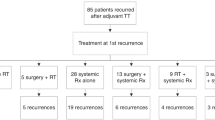Abstract
Fifty-five evaluable patients with disseminated malignant melanoma were treated with the combination of dacarbazine (DTIC) 400 mg i.v. on days 1 to 3 and lomustine (CCNU) 50 to 80 mg m-2 orally on day 1 with intervals of 6 weeks as the first line chemotherapy. Three (5%) patients had complete and 6 (11%) partial response, and 7 (13%) patients had stable disease at least for 3 months. The patients with an objective response (n = 9) survived longer than the rest of the patients if the length of survival was calculated from the start of chemotherapy (P = 0.0006). However, the responding patients also had longer time interval from the diagnosis to the detection of distant metastases (P = 0.05), and survival time from disease progression following DTIC and CCNU therapy (P = 0.005). These findings suggest that patients with an objective response to DTIC-CCNU therapy have melanoma with a slow progression rate, and prolonged survival in such patients may in part result from the less aggressive biological nature of their tumours.
This is a preview of subscription content, access via your institution
Access options
Subscribe to this journal
Receive 24 print issues and online access
$259.00 per year
only $10.79 per issue
Buy this article
- Purchase on Springer Link
- Instant access to full article PDF
Prices may be subject to local taxes which are calculated during checkout
Similar content being viewed by others
Author information
Authors and Affiliations
Rights and permissions
About this article
Cite this article
Joensuu, H. Association between chemotherapy response and rate of disease progression in disseminated melanoma. Br J Cancer 63, 154–156 (1991). https://doi.org/10.1038/bjc.1991.32
Issue Date:
DOI: https://doi.org/10.1038/bjc.1991.32
This article is cited by
-
Systemic therapy of malignant melanoma
Medical Oncology (1997)



